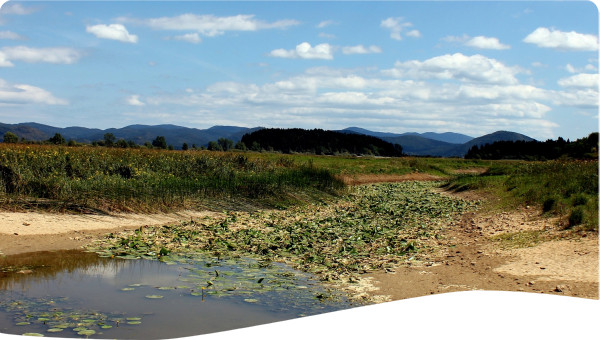The impacts of climate change will be amplified in the water environment, causing profound implications for the management of freshwater resources and those species who rely on those resources. There is consensus that impacts will appear through variability in the spatial-temporal availability of water, causing disruptions in hydrological cycles around the world. It is predicted that a few degrees of change in temperature will directly impact the water environment by causing more frequent and higher intensity (i.e., extreme) floods and droughts, alongside long-term changes in flow regimes. Climate change will not only negatively affect the availability of water but also its quality, creating implications for both water security, and sanitation and hygiene. The impacts of climate change are observed disproportionately, generating clear winners and losers (across communities/sectors/nations) – small island nations are particularly at risk (Robinson, 2017).
To deal with this increased water stress, national policies need to take an integrated approach to climate change, which embraces the links between water management and climate change. Here, the interaction between water and climate change should be considered as two sides of the same coin, with elements of water e.g., water investments (Tool D2.06), being important aspects of mitigation and adaptation. These relationships will require decisions to be made for allocating water resources between competing water users, including activities for climate change mitigation —to address the drivers of climate change and adaptation— and to consider the measures necessary to accommodate such changes. Climate change policies are thus an articulation of adaptation and mitigation, which set overarching goals, principles, mechanisms, technology, knowledge management etc., for building climate resilience. Policies identify and define sustainable development in a national context and highlight central themes and strategical objectives within each sector. As they do not establish deadlines or end dates for a particular plan or objective, policies can better withstand the test of time.
Water strongly influences a nations ability to adapt to the impacts of climate change. It can thus be argued that water is to climate adaptation, what energy is to climate mitigation (UN, 2019). Alligned with their climate change policy famework, many developing countries have developed National Adaptation Plans (NAPs) (Tool A3.08). NAPs are aimed to address and further expand on the crucial links between water and climate change adaptation, thus outlining how climate change policies can be executed at a national scale. NAP identify short- and long-term adaptation needs and develop and implement strategies/programmes to address those needs - such as flood and drought planning, adaptation in the agricultural sector, coastal zone management etc. (Tools A3). NAPs assist nations in adapting to climate change by highlighting entry-points, specific targets (or per sector targets) and their end dates, and methods necessary to reach these targets. For less developed countries, national adaptation programmes of action (NAPAs) can also be developed.
Albeit less prevalent as its link with adaptation, water resources utilised for mitigative activities can impact carbon emissions, whilst these same activities can influence the availability of water resources. For developed nations, who are top producers of GHGs, climate change mitigation strategies are an essential element of their national development policies and of their climate change policies. Here, many nations address their impact on global GHG emissions and thus contribution towards climate change by providing information on their Nationally Determined Contributions (NDCs). NDCs outline the voluntary commitments made by each nation on cutting their annual carbon emissions and identify the sectors in which mitigative measures can be employed. In addition, NDC address the important aspects of water for climate mitigation, such as water investments in watershed conservation to help reduce siltage which in turn reduces warming, or investments in wetland/mangrove restoration that can offer carbon capture and flood protection services.
- Linking water to adaptation and mitigation: Acknowledging water (i.e., water infrastructure development and management) as both an enabling and limiting factor for successful climate mitigation and adaption measures. Striving to strengthen and harmonise flood and drought management strategies (e.g., NAPs) and carbon emission reduction strategies (e.g., NDCs).
- Long-term visioning: Encouraging risk-based approaches that offer adaptive, “no-regret” solutions over the long-term. Supporting climate-aware government and development planning, to steer aware from a “business as usual” pathway to create a more sustainable future. Preferences for marginal changes rather than fundamental changes in development pathways.
- Multiple benefits: Allligning with the IWRM principles, climate change policies should strive to achieve social equity, economic efficiency, and environmental sustainability. Directing a special attention towards identifing measures that can offer multiple benefits, such as increased irrigation or energy efficiency.
- Ecosystem restoration: Featuring water protection as part of all climate change plans and activities, including national and regional development plans, with a focus on the protection and restoration of wetlands and aquifers. Building long-term resilience through Investments in climate-proof and natural infrastructure e.g., ecosystem-based approaches (Tool C3.04).
- Participation: Encouraging the active and continued engagement of stakeholders including local, regional, national, and international organizations, the public and private sectors, and civil society (including youth and vulnerable communities) (Tools B5; Tools C5).
- Balancing Soft and Hard Infrastructure: Prioritising and striking a balance between “soft” i.e., institutions, human resources, and “hard” i.e., infrastructure, interventions. This choice and balance between “hard” and “soft” approaches for a given adaptation strategy is influenced strongly by the nation’s financial situation.
- Multi-sectoral: Considering the multi-sectoral aspects of water use, conservation, and protection, and thus an awareness of the potential conflicts over available water resources between users (e.g., for adaptation and mitigation). This can be managed with the creation of flexible allocation systems and agreements.
- Multi-level: Designing frameworks at all levels, from small-scale projects to transboundary river basins, including those which cross administerial boundaries.
- Science-Based: Advocating for sound science and best practices. Knowledge and information sharing. Increasing investment in hydrological and climatological data collection and monitoring systems. The process of reducing uncertainty should be a guide for action, with the results embedded within management, planning, and design processes.

 Tool -
Tool -

